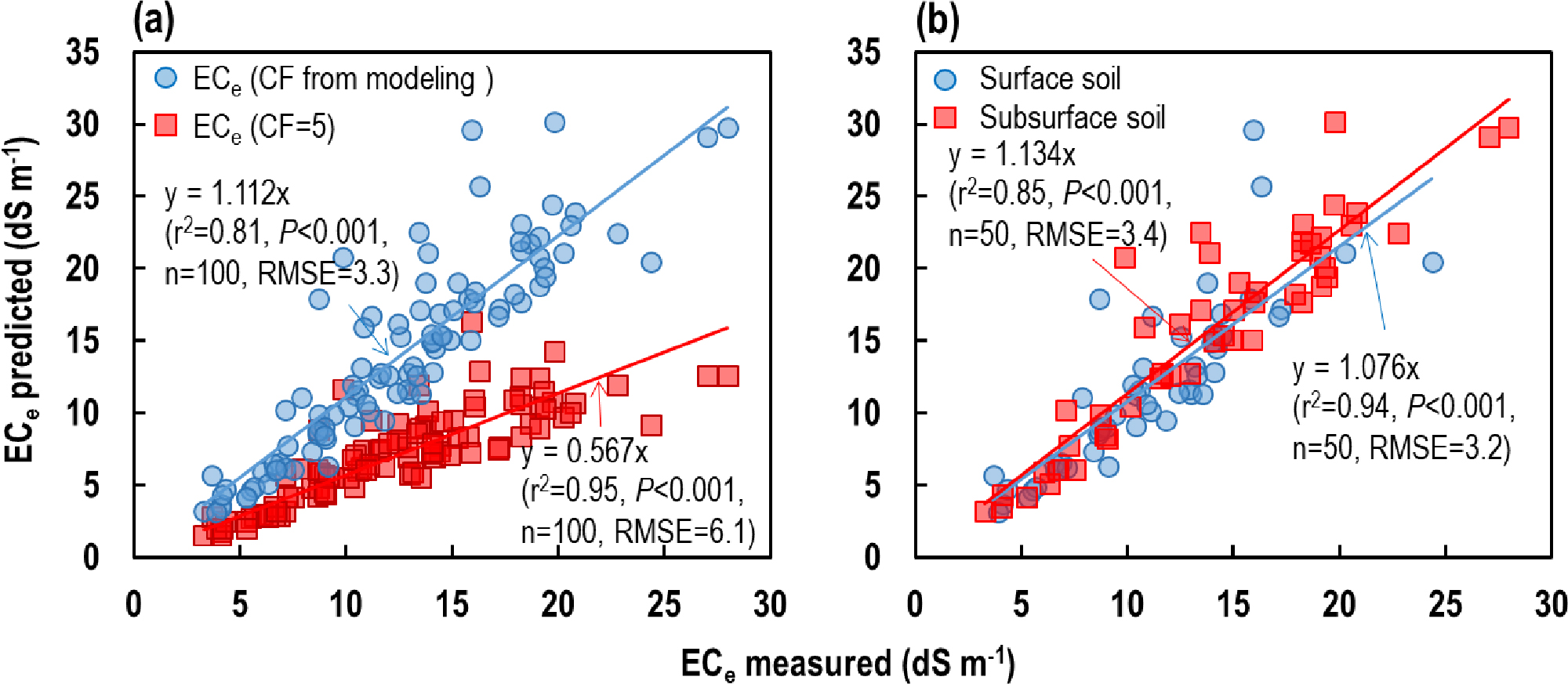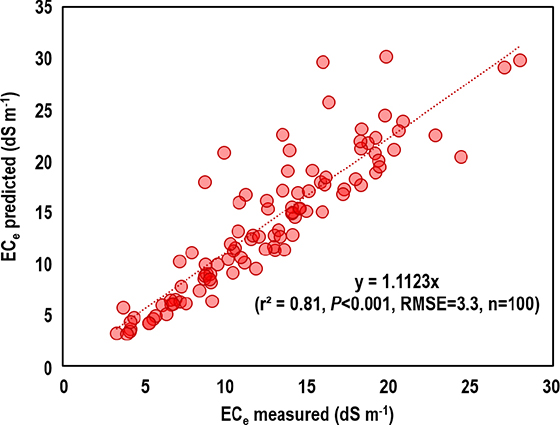Introduction
간척지는 염 농도가 매우 높기 때문에 적합 작물 선정 등 영농 관리를 위해서 염 농도 모니터링이 필요하다 (Lim et al., 2020; Lee et al., 2022; Seo et al., 2022b; Park and Choi, 2023). 토양 염 농도는 다양한 방법으로 측정하지만, 실험실에서는 대부분 토양 용액의 전기전도도 (electrical conductivity, EC)를 측정하여 평가한다 (Rhoades et al., 1989). 농작물의 내염성은 관행적으로 토양 포화반죽 침출액 EC (ECe)를 기준으로 설정되기 때문에 특정 토양의 염 농도 수준에 대한 작물 적합성 결정을 위해서는 ECe 측정이 필요하다 (Abrol et al., 1988). 그러나, ECe 측정은 분석과정이 복잡하며 많은 시간과 인력이 필요하며, 숙련도에 따라 정확성이 달라지는 단점이 있다 (Al-Busaidi et al., 2006; Park et al., 2019). 반면, 토양 시료에 일정 비율의 증류수를 혼합한 침출액의 EC (ECw)의 경우 측정이 간편하지만, 희석 효과에 의해 ECe에 비해 이온 농도와 전기전도도가 일반적으로 더 낮게 측정된다 (Sonmez et al., 2008; Seo et al., 2021). 따라서, ECw를 ECe로 환산할 수 있는 다양한 방법이 모색되고 있다 (Sonmez et al., 2008; Khorsandi and Yazdi, 2011; Aboukila and Abdelaty, 2017; Gharaibeh et al., 2021).
우리나라에서는 토양과 증류수의 비율을 1:5로 한 침출액의 EC (EC1:5)의 경우 환산 계수 5를 적용하고 있으나 (NAAS, 2010), 국제적으로 ECw와 ECe의 상관관계에 대한 많은 연구가 진행되었으며, EC1:5에 대한 ECe 환산 계수는 EC1:5와 ECe의 상관관계의 기울기 값인 5.0 - 11.7로 보고되고 있다 (Sonmez et al., 2008; Chi and Wang, 2010; Khorsandi and Yazdi, 2011; Aboukila and Abdelaty, 2017; Kargas et al., 2020). 하지만, EC 환산 계수는 점토 광물의 종류 (Sonmez et al., 2008), 황산 칼슘 함량 (Khorsandi and Yazdi, 2011), 나트륨 흡착비 (sodium adsorption ratio, SAR) (Park et al., 2019), 포화수분함량 (Gharaibeh et al., 2021), 모래 함량 (Seo et al., 2022a) 등 토양의 다양한 물리화학성에 영향을 받으므로 이를 고려한 EC 환산 계수 개발이 필요하다.
최근, 우리나라 서해안 간척지 논 토양 (n = 320)을 대상으로 random forest (RF) 방법을 이용하여 EC 환산 계수에 대한 영향 요인을 추출하고 다중회귀모형을 이용하여 EC 환산 계수를 산정할 수 있는 방법론이 개발되었다 (Park et al., 2024). 해당 연구에서는 RF 모델을 이용하여 EC 환산 계수 변동에 대한 기여도가 교환성 나트륨 비 (exchangeable sodium percentage, ESP)가 56.6%로 가장 높았고, 점토 (clay) 함량이 20.0%임을 확인하였고, 이 변수들을 이용하여 EC 환산 계수 (conversion factor)를 산정할 수 있는 다중회귀모형을 Conversion Factor = 7.179 - 0.084 × Clay + 1.096 × ln(ESP)와 같이 제안하였다. 이 다중회귀모형은 기존의 EC1:5-ECe의 단순회귀 모형의 한계를 극복한 모형으로 활용도가 높을 것으로 예상되어, 해당 모형의 정확도 평가가 필요하다. 따라서, 본 연구에서는 우리나라 간척지 토양을 대상으로 Park et al. (2024)의 연구에서 제안한 EC 환산 계수 산정 다중회귀모형의 정확도를 평가하였다.
Materials and Methods
본 연구에서는 EC 환산 계수 산정식을 검증하기 위해 2023년 국립식량과학원에서 연구비를 지원하여 전남대학교에서 실시한 남부 국가 간척지 (고흥, 군내, 보전, 삼산, 영산강) 농업환경 변동 조사 자료를 활용하였다. 해당 변동 조사에서는 고흥 (면적: 3,100 ha), 군내 (1,381 ha), 보전 (298 ha), 삼산 (420 ha), 영산강 (30,359 ha) 간척지에서 지구별로 각각 9, 7, 6, 8, 20개 필지를 선택하여 전체 50개 필지에서 토양 시료를 채취하였다. 토양 시료는 영농기 전 (2 - 4월)에 표토 (0 - 30 cm)와 심토 (30 - 60 cm)에서 총 100점을 채취하였다. 채취한 시료는 풍건 후 2 mm 체 거름하여 분석에 사용하였다.
토양 EC1:5는 교반용 100 mL 플라스틱 통에 토양 10 g과 증류수 50 mL를 넣고 150 rpm에서 30분 교반한 후 여과지에 여과한 액을 EC meter (Orion 3 STAR, Thermo Fisher Scientific Korea, Seoul, Korea)로 측정하였다. 토양의 ECe는 200 - 300 g의 토양 시료를 500 mL 플라스틱 통에 담고 증류수를 천천히 넣어가며 포화반죽하여 24시간 방치 후 진공용액추출기 (SampleTek 24VE, MAVCO INDUSTREIS, Inc., Kentucky, USA)로 침출액을 추출하여 EC1:5와 동일하게 EC meter를 사용하여 측정하였다 (Rhoades et al., 1989). 토양시료의 점토 함량은 Pipette 법을 이용하여 분석하였다 (Gee and Bauder, 1986). 또한, Ammonium acetate 법을 이용하여 토양의 양이온 교환 용량을 분석하였다 (Sumner and Miller, 1996). Ammonium acetate 침출액의 교환성 Na+ 농도를 원자흡수분광광도계 (Analyst 800, Perkin Elmer, Waltham, USA)를 이용하여 분석하여, 다음 Eq. 1과 같이 ESP를 계산하였다 (Horneck et al., 2007).
ESP : exchangeable sodium percentage (%)
[Na+]exchangeable : molar concentration of exchangeable sodium (cmolc kg-1)
CEC : cation exchange capacity (cmolc kg-1)
점토 함량과 ESP를 Park et al. (2024)의 EC 환산 계수 산정식에 대입하여 각 토양 시료별 EC 환산 계수를 계산하여 EC1:5와 곱하여 ECe를 예측하였다. 실측 ECe와 예측 ECe의 상관관계 회귀식의 기울기와 결정계수 (r2), 그리고 두 가지 ECe의 평균 제곱근 오차 (root mean square error, RMSE)를 계산하였다. 실측 ECe와 예측 ECe의 상관관계는 IBM SPSS Statistics 27 (IBM Corp., Amonk, New York, USA)을 이용하였으며 통계적 유의성은 95% 수준에서 검토하였다.
Results and Discussion
조사된 100점의 토양 시료의 EC1:5는 0.3 - 3.3 dS m-1 (평균: 1.4 ± 0.6)의 범위였으며, ECe는 3.3 - 28.0 dS m-1 (12.5 ± 5.4)로 염 농도 수준이 매우 다양하였다. 또한, 다중회귀모형의 EC 환산 계수 결정 인자인 점토 함량과 ESP는 각각 3.2 - 53.3% (22.8 ± 12.2)와 3.8 - 147.5% (58.3 ± 30.8)로 분포하였다. 총 100점 시료에 대해 측정된 ECe:EC1:5는 4.2 - 13.3의 범위였고, Park et al. (2024)이 제시한 다중회귀 모형에 점토함량과 ESP를 입력하여 계산한 환산 계수는 5.7 - 11.9로 분포하였다. 이와 같은 EC 환산 계수 범위는 선행연구에서 보고된 범위 (5.0 - 11.7)와 유사하였다 (Sonmez et al., 2008; Chi and Wang, 2010; Khorsandi and Yazdi, 2011; Aboukila and Abdelaty, 2017; Kargas et al., 2020).
측정 ECe와 환산 ECe는 직선의 상관관계 (r2 = 0.81, P < 0.001, RMSE = 3.3)가 있었으며 기울기는 1.112로 환산 ECe가 약 11.2% 과대평가되는 것으로 나타났다 (Fig. 1a). 토양 깊이 별 측정 ECe와 환산 ECe는 표토 (r2 = 0.94, P < 0.001, RMSE = 3.2)와 심토 (r2 = 0.85, P < 0.001, RMSE = 3.4) 모두 직선의 상관관계가 있었으며, 각각의 기울기 (1.076과 1.134)에서 확인할 수 있듯이 표토 (7.6%)가 심토 (13.4%)에 비해 환산 ECe의 오차가 더 낮았다 (Fig. 1b). 또한, 지구별로 동일한 방식을 적용했을 때 환산 ECe의 오차가 보전 (2.4%), 영산강 지구 (1.9%) 토양이 고흥 (22.7%), 삼산 (16.1%), 군내지구 (19.4%)에 비해 낮았다.
Park et al. (2024)의 선행연구에서는 320 점의 시료 중 160 점의 데이터를 이용하여 EC 환산 다중회귀모형을 개발하고, 나머지 절반의 데이터로 이 모형을 검증하여 오차가 약 3.1%로 상대적으로 낮았다. 하지만, 본 연구에서는 Park et al. (2024)의 연구와는 다른 시료를 이용하였기 때문에 오차가 상대적으로 높은 것으로 판단된다. 또한, Park et al. (2024)은 EC 환산 계수에 대한 영향 인자로 점토 함량과 ESP를 고려하였지만, EC 환산 계수는 모래 함량 (Seo et al., 2022a)과 SAR (Park et al., 2019) 등 다른 요인에 의해서도 영향을 받는다. 뿐만 아니라, 지구별 토양 시료의 수가 동일하지 않으므로 오차에 대한 정확한 요인을 분석하기 위하여 동일 조건으로 추가적인 자료가 필요할 것으로 보인다. 이와 같은 오차에도 불구하고, 본 연구에서 확인한 오차 (11.2%)는 현재 우리나라에서 관행적으로 사용되고 있는 환산 계수인 5를 적용했을 때의 오차 (43%) 보다는 매우 양호하였다 (Fig. 1a).
비록 본 연구에서 Park et al. (2024)이 제안한 EC 환산 계수 산정 다중회귀모형의 오차가 10% 이상이었지만, 방법론적으로 ECe 측정 자체의 오차 가능성이 높은 점을 고려하면 해당 다중회귀모형 활용 가능성은 높은 것으로 판단된다. 일반 농경지 토양에 대해서는 ESP에 대한 실험 자료가 부족할 수 있지만, 간척지 토양 조사 사업에서는 토성과 ESP가 기본 조사 항목이기 때문에 Park et al. (2024)의 EC 환산 계수 산정 다중회귀모형 적용이 가능할 것으로 기대된다. 또한, 정확도가 다소 낮은 전자기 방식의 EC 모니터링이 도입되는 것을 고려하면 (Seo et al., 2022a), EC1:5를 실측하여 ECe로 환산하는 방법도 간척농지 ECe 장기 모니터링 방법론의 대안이 될 수 있다.

Fig. 1.
Relationship between the electrical conductivity (EC) of saturated soil paste extracts (ECe) measured and the ECe predicted: (a) ECe of entire soil samples (both surface and subsurface soils) predicted using the soil-specific conversion factor (CF) obtained from the multiple regression model suggested by Park et al. (2024) (blue circle) vs. ECe predicted using single CF (5) recommended by the Rural Development Administration (red square) and (b) ECe predicted using the CF from modeling for surface vs. subsurface soils.
Conclusions
본 연구에서는 EC1:5를 ECe로 간편하게 환산할 수 있는 방법 모색을 위해, 기존에 개발된 EC 환산 계수 산정 다중회귀모형의 정확성을 검증하였다. 토양 점토 함량과 ESP를 주요 매개변수로 활용하는 다중회귀모형으로 계산한 환산 계수를 적용하여 산출한 ECe가 실측 ECe에 비해 11.2% 과대평가되었으나 직선적 상관관계가 있음을 확인하였다. 점토 함량과 ESP는 간척지 토양 조사 사업의 기본 모니터링 자료이므로, 관련 자료 (EC1:5, 점토 함량과 ESP)가 있는 경우 EC 환산 계수 산정 다중회귀모형을 적용하여 ECe를 도출하여 ECe 장기 모니터링에 활용할 수 있을 것으로 기대된다. 특히, 많은 시간과 비용이 소모되며, 숙련도에 따른 정밀도와 정확도가 달라지는 기존의 ECe 분석 방법의 단점을 고려하면 본 연구에서 검증한 환산 계수 산정 다중회귀모형을 적극적으로 활용할 필요가 있다. 이 EC 산정 방법의 오차는 조사 대상 지점 일부 시료에 대해서 EC1:5와 ECe를 측정하여 보정할 수 있을 것으로 판단된다.





